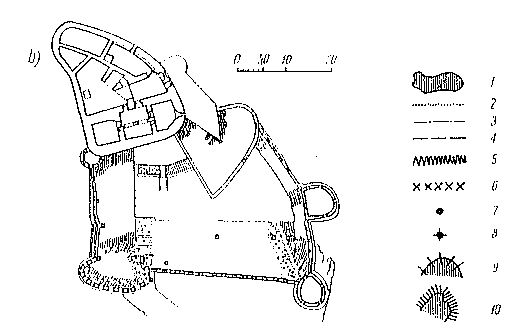Due to the unusual nature of the security works and the very wide range of technical issues involved, the development of the concept of securing the hill and the castle in Niedzica was commissioned to a team of specialist departments of the Cracow University of Technology.
As a result of the conducted studies and research, a concept was presented from several possible variants, whose main ideas are summarized in the following assumptions.
 The concept of securing the area of the castle in Niedzica, XIV—XVI w.: b) assumption projection, 1 - pre-Quaternary ground, 2 - damming level to tank tier 510,0 m, 3 - tank damming level (ordinate 529,0 m), 4 - tank damming level (government 534,5 m), 5 - removal areas, 6—pale Wolfsholza, 7 — cement-clay injections on the row 529,0 m, 8 — cement-clay injections on the row 521,5 m to a depth of 15.0-17.0 m, 9 - reinforced concrete coat, thick. 50 cm set on drilled piles ∅ 30 cm at a distance of .1.0 - 4.0 m, 10 - concrete coat thick. 35 cm i wys. 7,0 m
The concept of securing the area of the castle in Niedzica, XIV—XVI w.: b) assumption projection, 1 - pre-Quaternary ground, 2 - damming level to tank tier 510,0 m, 3 - tank damming level (ordinate 529,0 m), 4 - tank damming level (government 534,5 m), 5 - removal areas, 6—pale Wolfsholza, 7 — cement-clay injections on the row 529,0 m, 8 — cement-clay injections on the row 521,5 m to a depth of 15.0-17.0 m, 9 - reinforced concrete coat, thick. 50 cm set on drilled piles ∅ 30 cm at a distance of .1.0 - 4.0 m, 10 - concrete coat thick. 35 cm i wys. 7,0 m
The problem of securing the Niedzica castle hill boils down to two basic tasks:
a) wzmocnienie skał, of which the promontory most protruding towards the lagoon is formed, and protect them from erosion,
b) ustabilizowanie i zabezpieczenie pokrywy zboczy i warstw głębszych w bliskim sąsiedztwie zamku przed abrazją (being washed away by the waves), against runoffs and landslides, to which the north-western and eastern slopes are particularly susceptible.
The following technical measures are foreseen.
In the zone of the most intensive water activity, an underground protective embankment with a depth of approx, 20 m and a width of approx. 15—20 m, which will be built approx. 450 m by strengthening the slope of the reservoir with cement-clay injections. This protection will make it difficult to infiltrate water into the rock mass and will improve the stability of the hill. Limestone rocks exposed and showing a clear tendency to disintegrate will be enclosed with a reinforced concrete protective coat, closely adapted to the form and texture of the rocks. this coat, height approx. 7,0 m and a thickness of 0.35-0.50 m, will be properly anchored to the bedrock; it will protrude above the highest water level to a height of approx. 2,0 m.
The hill cover in the most endangered places will be fixed to the underlying rock formations by means of piling. They will be reinforced concrete piles, wiercone, properly reinforced and sunk into the rock to a depth of approx. 2,0 m. Their task will be to oppose the forces, which will occur with the tendencies of sliding movements of the slope. Diameter reinforced concrete piles 30 cm will be distributed in 2 do 4 rows at a distance of 2.0-3.0 m; they will create two to three barriers on the slopes, which, together with other measures, will secure the stability of the slopes of the hill.
Suggested use of these, and no other means of securing the hill, on whose stability the fate of such a valuable monument depends, which is Niedzica castle, has been supported by extensive scientific evidence, The need to protect the natural landscape directly surrounding the castle was also taken into account.
The structural protection of the complex of castle buildings was the subject of separate studies. In essence, this problem boiled down to the introduction of elements, which will increase the overall spatial stiffness of the structure and make it less sensitive to the effects of deformation, caused by possible ground movements. In addition, the issues of adapting materials and structures to work in new environmental and climatic conditions will be taken into account.